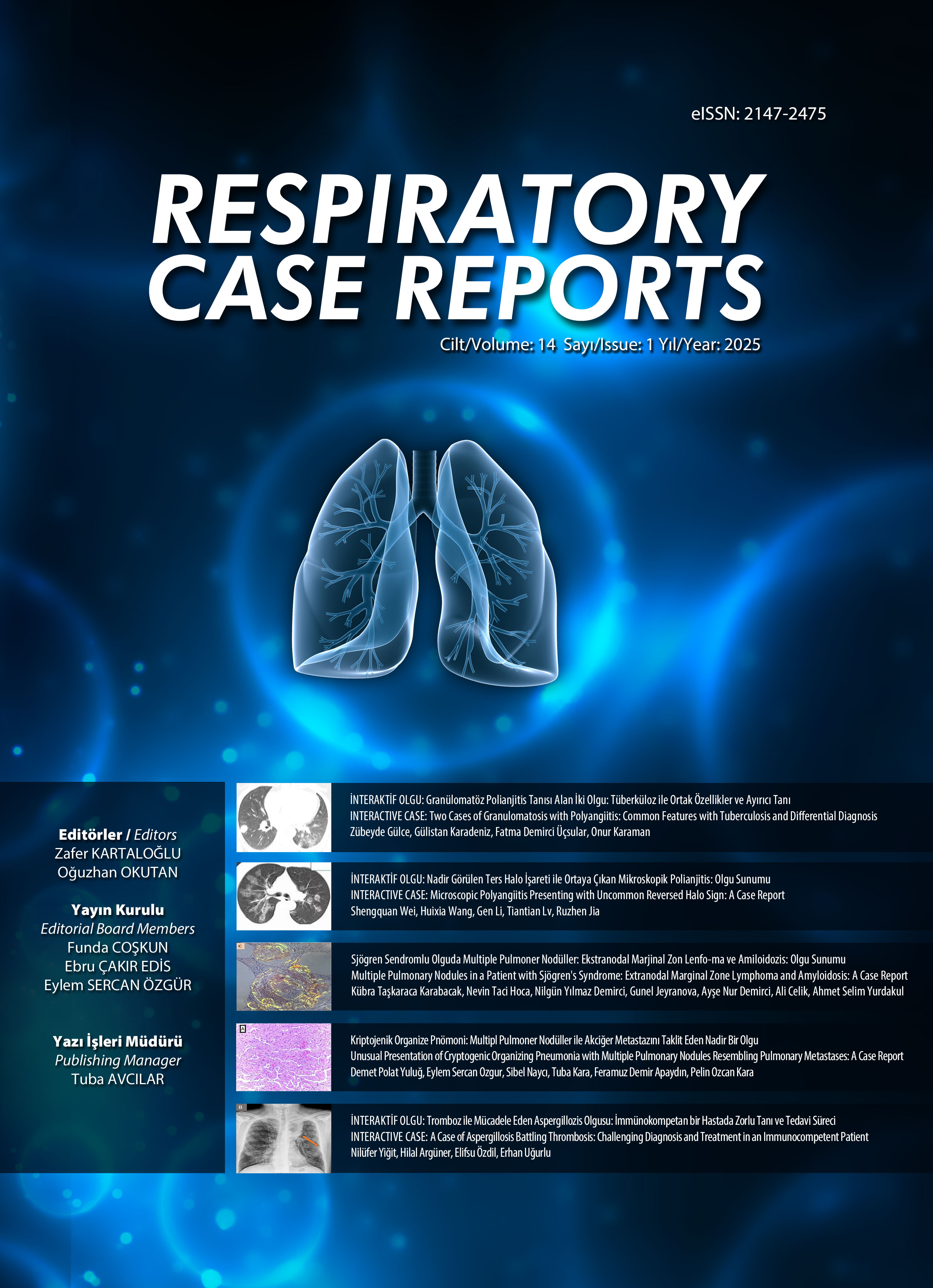e-ISSN 2147-2475

Volume: 9 Issue: 3 - October 2020
| CASE REPORT | |
| 1. | Effectiveness of Favipiravir prior to Admission to the Intensive Care Unit in COVID-19 Pneumonia Önder Öztürk, Volkan Bağlan, Onur Kaya, Esra Nurlu Temel, Onur Ünal, Veysel Atilla Ayyıldız, Mümtaz Cem Şirin, Fevzıye Burcu Şirin, Gul Ruhsar Yilmaz, Fusun Zeynep Akcam, Münire Çakır, Ahmet Akkaya doi: 10.5505/respircase.2020.09216 Pages 99 - 103 After emerging in Wuhan city in December 2019, the coronavirus disease 2019 (COVID-19) rapidly spread throughout China. Although high rates of hospitalization are seen with COVID-19, no specific treatment has been reported, and the choice of antiviral therapies is limited. Favipiravir, approved in Japan for influenza, is one of the drugs that targets RNA-dependent RNA polymerase (RdRP). It significantly decreases the duration of fever, cough dyspnea, and the need of oxygen therapy or noninvasive mechanical ventilation, especially in moderate COVID-19 cases. In the current paper we presented four cases with worsening clinical conditions and the development of hypoxia who were treated with Favipiravir before being admitted to the intensive care unit, and who recovered from the disease. |
| 2. | Kimura Disease: Cervical, Supraclavicular and Mediastinal Lymphadenopathy Mimicking Lymphoma Cenk Balta, Mustafa Kuzucuoğlu, Eren Altun doi: 10.5505/respircase.2020.31932 Pages 104 - 107 Kimura disease is rarely seen benign chronic inflammatory disease, the etiology of which is unknown. The diagnosis of the disease is challenging, and so histopathological sampling is necessary. Eosinophilia, increased serum immunoglobulin E levels and subcutaneous nodules in the head and neck are the classical triad indicators of the disease. Herein, we present the case of a 33-year-old man with multiple lymphadenopathies in the area of neck, supraclavicular and mediastinum. The patient was pre-diagnosed with lymphoma. After a supraclavicular lymph node excision, the diagnosis was re-evaluated as Kimura Disease. |
| 3. | A Case of Pulmonary Capillary Hemangiomatosis in a Worker with Exposure to Foundry Dust and VOCs Ayse Coskun Beyan, Arif Cimrin, Duygu Gürel doi: 10.5505/respircase.2020.70894 Pages 108 - 111 Pulmonary capillary hemangiomatosis (PCH) is a rare and progressive vascular disease of the lung that causes pulmonary hypertension, as they frequently overlap. The occupational risk factor associated with PCH is rarely discussed. In the present report, three of the eight patients admitted from the same company had similar radiological findings, and one agreed to undergo a biopsy. A 40-year-old male who was working as a foundry worker with no symptoms underwent CT, which showed moderate peribronchial thickening in both lungs and a mosaic perfusion pattern in the lower zones. There was no evidence of right heart failure. A microscopic examination of the lung by thoracoscopic resection showed capillary-like vascular proliferation in the alveolar septa. As there were workers with similar radiological findings from the same company he was diagnosed with occupational PCH. The etiology of PCH remains unknown. Occupational exposure should be kept in mind if a disease does not meet the classic epidemiological characteristics. |
| 4. | Septic Pulmonary Embolism Associated with Acinetobacter Pneumonia Emine Afşin doi: 10.5505/respircase.2020.18199 Pages 112 - 116 Septic pulmonary embolism is an infective lung disease that leads to infarction in the pulmonary arteries and bilateral multiple nodules and/or cavitations in the lung parenchyma resulting from the circulation of thrombus in the bloodstream as infected with microorganisms in the primary infectious focus. A 58-year-old case we have presented was hospitalized with the diagnosis of COPD exacerbation and was taken to the intensive care unit to be monitored in the invasive mechanical ventilator because of fever, cough, increased dyspnea and development of bilateral diffuse infiltration encountered by chest x-ray. Thoracic computed tomography encountered peripherally localized and partly cavitary nodules, infiltration, mediastinal lymphadenomegaly with a maximum diameter of 1 cm, bilateral pleural effusion and feeding vessel sign. After exitus of the patient who was unresponsive to broad spectrum antibiotic and antifungal therapy; tracheal aspirate culture test indicated the growth of Acinetobacter baumannii /calcoaceticus (resistant to all the antibiotics in the antibiogram). The detection of Gram Negative Pneumonia has been rarely reported in the etiology of septic pulmonary embolism that presents a high mortality rate, therefore, we aimed to discuss that case in the light of literature data. |
| 5. | Diagnosis of Pulmonary Hydatid Cyst with Point of Care Ultrasound in an Emergency Department: A Case Report Nalan Kozaci, Mustafa Avcı doi: 10.5505/respircase.2020.37132 Pages 117 - 121 Ultrasonography is widely used for diagnostic and invasive purposes in emergency departments. We present here a case with acquired immune deficiency syndrome who was diagnosed with a hydatid cyst and pneumonia in the lung parenchyma during a point-of-care-ultrasonography examination. |
| 6. | Thoracoabdominal Rebar Injury: A Case Report Tolga Semerkant doi: 10.5505/respircase.2020.32154 Pages 122 - 124 The removal of the foreign body form the body after a penetrant injury is critical. A 32-year-old male patient presented to our facility after falling on an iron reinforcement bar (rebar) while working on a construction site. The iron bar had entered the lateral side of the patients left umbilicus and exited from the posterior scapula. After a physical examination and the necessary radiological investigations, the patient was operated on. Due to the position of the iron bar, the physical examination, radiological examinations, intubation and surgery were conducted with the patient slightly left of the lateral decubitus position, and the iron bar was removed. Although such cases are encountered only rarely, we consider it to be crucial for the emergency and surgical teams to work in coordination. |
| 7. | A Rare Case of Pulmonary Fibrosarcoma Treated by Sleeve Lobectomy Demet Turan, Mehmet Akif Ozgul, Levent Cansever, Mehmet Ali Bedirhan doi: 10.5505/respircase.2020.04127 Pages 125 - 128 A 28-year-old male presented to the emergency department with hemoptysis. A pulmonary examination revealed diminished lung sound on left side, and a CT scan of the chest showed an endobronchial polipoid lesion in the left main bronchus. A rigid bronchoscopy showed a polipoid lesion in left the main left bronchus, while the orifice of the lower lobe was not visible. The lesion was cut into two pieces with a snare and removed with cryotherapy, and hemostasis was achieved. A pathological examination of the lung bronchial biopsy specimen revealed fibrosarcoma. A left lower sleeve lobectomy was performed, and as surgical margins were tumor free, no chemo/radiotherapy was considered necessary. Primary endobronchial pulmonary fibrosarcomas exhibiting polypoid growths are rare. Surgical excision is the preferred treatment option in such patients |
| 8. | Solitary Langerhans Cell Histiocytosis of the Rib Demet Yaldız, Mehmet Sadık Yaldız, Peyker Temiz, Cihan Göktan doi: 10.5505/respircase.2020.79058 Pages 129 - 131 Isolated rib involvement is one of the rarest sites for the clinical presentation of Langerhans cell histiocytosis (LCH). We report here on the case of 29-year-old female whose only symptom was pain, radiating to the solitary osteolytic lesion at the posterolateral aspect of her seventh rib. The 7th rib was resected for diagnostic confirmation and treatment, and histopathological findings were found to be compatible with the LCH. |
| 9. | Surgical Treatment of a Case of Tracheobronchopathia Osteochondroplastica with a Thymic Cyst Kenan Can Ceylan, Hüseyin Mestan, Şeyda Örs Kaya doi: 10.5505/respircase.2020.47568 Pages 132 - 135 Tracheobronchopathia osteochondroplastica is a rare benign disease that is characterized by multiple submucosal osseous and cartilaginous nodules in the tracheal bronchus. The etiology is not clear. A thoracic computed tomography of a 75 year-old female patient with complaints of dyspnea and cough for a year revealed two different lesions on the trachea and the anterior mediastinum. A bronchoscopy revealed a solid mass in the distal part of the trachea, affecting 45 cartilaginous rings and restricting the tracheal lumen by approximately 70%. The mass was located approximately two cartilaginous rings distant to the carina. A tracheal sleeve resection and thymectomy were performed through a right thoracotomy. The histopathological results indicated tracheobronchopathia osteochondroplastica and a thymic cyst. The postoperative follow up was uneventful. We report this rare case since the co-existence of tracheobronchopathia osteochondroplastica and the thymic cyst is a condition rarely seen in literature. |
| 10. | Marfan Syndrome: A Case Report Mediha Gönenç Ortaköylü, Tuğçe Özen, Belma Akbaba Bağcı, Esma Seda Akalın Karaca doi: 10.5505/respircase.2020.88609 Pages 136 - 142 Marfan syndrome (MFS) is a connective tissue disorder inherited by autosomal dominant pattern that affects primarily cardiovascular, ocular, musculoskeletal and nervous systems. Even though, mutation in the fibrillin-1 gene (FBN1) located on Chromosome 15 was detected in 66-91% in the case with MFS, 27% of the cases were caused by novel mutations. The clinical diagnosis in adults is established according to Ghent Criteria. Early diagnosis, aortic valve-sparing medical and surgical treatments, and regular patient follow-up are helpful in preventing and delaying serious complications. In this case report, we have presented a 30-year-old case who admitted to the hospital due to the complaints of purulent bloody sputum, fever and sweating, and was diagnosed with Marfan syndrome. |
| 11. | Author Index Pages 143 - 144 Abstract | |
| 12. | Reviewer Index Page 145 Abstract | |











